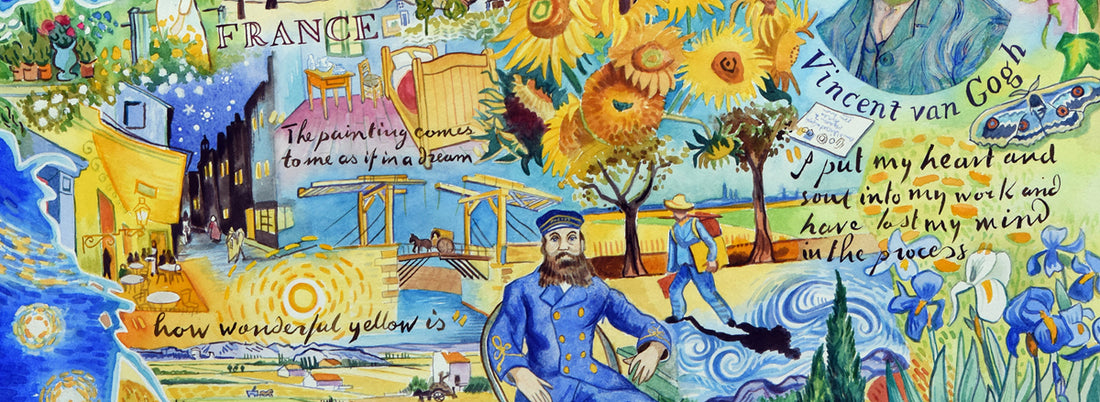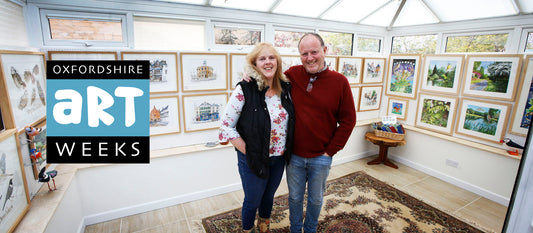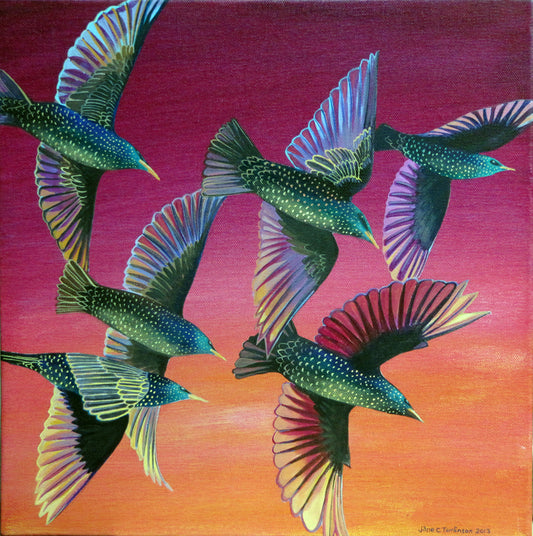
Map of Vincent van Gogh - a painting of the places Vincent lived and worked
A hand-painted map of the places Vincent van Gogh lived and worked

47 paintings in one!
My painting of the life and works of Vincent van Gogh is a map of where he lived, when he lived there, and what he painted when he was in that location.
You can get an A2 sized poster of this painting here.
I’ve been gripped by Vincent van Gogh since 1979 when on a school trip to London’s National Gallery, the Sunflowers hit me right between the eyes. Thanks to my art teacher, John Blunt for this life-changing trip! More than 4 decades of studying his works later, I still ‘discover’ paintings and drawing I’ve never seen before.
In my map of Vincent, I chose many of his best-loved paintings, and also lesser known works that show Vincent’s extraordinarily wide range of subjects: boats, trees, flowers, people, architecture, tree and even the stars.
What’s in the map of Vincent?
England
- Churches at Petersham and Turnham Green – Sketch in a letter of where Vincent was working in 1873.
- Books (1888)- Vincent read so much while he was in England, and not just the bible. He was especially fond of Dickens.
- Pieta (after Delacroix) – Vincent was especially religious while he was in England. He didn’t paint this copy of a Delacroix until 1889.
- Sailing boat in the channel from a sketch in a letter (1882).
- Almond Blossom – Vincent would have been familiar with the many blossoming trees in London’s public parks. He didn’t paint Almond Blossom until 1890.
- The Starry Night (1889) – I have used and adapted sections from this most-loved of Vincent’s painting to represent the sea.
The Netherlands and Belgium
- Bulb fields (1883) – One of Vincent’s earliest garden paintings.
- Cottages in Drenthe (1883) – He was fascinated by ordinary people’s homes, no matter humble.
-
Sorrow (1882) – A sketch in a letter of Sien, the woman he lived with in The Hague.
- Drawbridge in Nieuw-Amsterdam (1883) – From the house where he stayed in Drenthe he could “look out on a very curious drawbridge.” He made this luminous watercolour.
- Man pulling a harrow (1883) – Sketch in a letter. The dignity of the labours of ordinary folk was a subject he returned to often.
- Boy Cutting Grass with a Sickle (1881) – Just a fabulous watercolour!
- Pollarded Birches (1884) – A masterful drawing of one of his favourite subjects – trees.
- The Potato Eaters (1885) – He considered this painting to be his first masterpiece. It’s not pretty, but he’s right.
- The Sower (after Millet) (1881) – He loved Jean-Francois Millet’s heroic peasant figures – the Sower was a favourite.
- Au Charbonnage Café (1878) – A sketch of a café in Brussels.
- Skull with a Cigarette (1886) – Painted while he was at the Antwerp Academy, perhaps it’s a macabre comment on his own poor health at this time?
- The Decrucq family home (1880) – Sketch in a letter of the house he lived in in Cuesmes.
- Quayside with Ships in Antwerp (1885) – He loved the bustle of the docks and made many sketches of the people coming and going, working and drinking.
France – the north
- Church at Auvers (1890) – One of Vincent’s most celebrated late canvases from Auvers-sur-Oise, where he is buried.
- Portrait of Agostina Segatori at the Café Tambourin (1887) – He knew the cafe intimately, it was a favourite haunt for many artists in Paris at the time.
- Wheatfield with crows (1890) – There is no proof that this was the last canvas he painted, although popular culture would like it to be!
- Marguerite Gachet in the Garden (1890) – Was he a little bit in love with her? Maybe. He certainly loved going to Dr Gachet’s house.
- Moulin de Galette (1886) – He lived with his brother Theo close to this windmill in Montmartre.
- Farms near Auvers (1890) – “Here there are roofs of mossy thatch which are superb, and of which I’ll certainly do something” he wrote to his sister, Wil.
- Café Terrace at Night (1888) – “…a painting of night without black. With nothing but beautiful blue, violet and green, and in these surroundings the lighted square is coloured pale sulphur, lemon green. I enormously enjoy painting on the spot at night.”
- Artist’s Bedroom in Arles (1888) – Vincent was proud of the very original thought and meaning behind this painting – he copied it three times!
- The Munich Sunflowers (1888) – One of a series of paintings of “nothing but large sunflowers”. This one is my favourite.
- Pont Langlois (1888) – He made 4 paintings of this little lifting bridge over the Bouc canal. Bridges, canals… it reminded him of home.
France – the south
- The Harvest (1888) – One of series of landscapes of Le Crau which he made outside in the heat during an especially productive period. He wrote enthusiastically: ‘this canvas absolutely kills all the rest’. Read more.
- Portrait of Joseph Roulin (1888) – The Roulin family were true friends to Vincent and became his ‘adopted’ family in Arles.
- The painter on the road to Tarascon (1888) – This canvas is now lost, probably destroyed by fire during an air raid on Germany in the second world war.
- Wheatfield with Cypresses (1889) – Painted when he was staying at the asylum at Saint-Rémy.
- Still Life with Blue Enamel Coffeepot, Earthenware and Fruit (1888) – He painted many still lives, but this one is my favourite – a perfect composition, perfect colour balance and perfectly painted.
- Self portrait with Bandaged Ear (1889) – An extraordinary portrait painted just after the most notorious act of self-harm in the whole of the history of art! Why did he do it?
- The Artist’s Chair and Pipe (1888) – If you’ve ever tried to draw – let alone paint – a chair, and give it meaning, you’ll understand what a masterpiece this apparently simple composition is.
- The Yellow House (1888) – The house at 2 Place Lamartine, Arles where he lived in for 8 months in 1888. The house was destroyed by stray Allied bombs on 25 June 1945.
- View of Saintes-Maries (1888) – In June Vincent took the stagecoach from Arles and travelled the 30 miles to Les Saintes-Maries-de-la-Mer, a fishing village in the Camargue, where in just a few days he made 3 paintings and 9 drawings.
- A Pair of Leather Clogs (1889) – Vincent made many paintings of shoes and boots
- Olive Grove (1889) – The asylum at St Remy where Vincent stayed in 1889 was surrounded by olives orchards. He made 18 paintings of these trees. By this time his religious faith had long disappeared, but still, for Vincent, they retained a symbolic quality.
- Boat from Fishing Boats on the Beach at Saintes-Maries (1888)
- Stars from Starry Night over the Rhone (1888) used to depict the sea.
And finally, the bottom right section
-
Self -portrait (1889) – Vincent wrote to Theo: “You will need to study
for a time. I hope you will notice that my facial expressions have become much calmer, although my eyes have the same insecure look as before.” - Letter from Still Life with Drawing Board, Pipe, Onions and Sealing-Wax (188x) –
- Great Peacock Moth (1889) – He found this large moth in the gardens at the asylum. He often painted butterflies, a symbol of hope. “Yesterday I drew a very large, rather rare night moth, its coloration astonishingly distinguished … the animal was so beautiful.”
- Irises (1889) – These grow wild round the asylum. In 1987, this painting became the most expensive painting ever sold at US$53.9 million.
- Fishing Boats on the Beach at Saintes-Maries (1888). I love the letter he sent to Theo from Saintes-Maries.
And finally, around Vincent’s head I have painted ivy. Ivy now grows on the graves of the van Gogh brothers in Auvers, binding them together in death, as they were in life.



